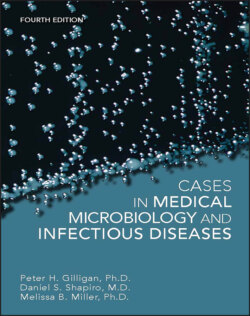Читать книгу Cases in Medical Microbiology and Infectious Diseases - Melissa B. Miller - Страница 17
DIRECT EXAMINATION Macroscopic
ОглавлениеOnce a specimen is received in the clinical laboratory, the first step in the determination of the cause of an infection is to examine it. Frequently, infected urine, joint, or cerebrospinal fluid specimens will be “cloudy” because of the presence of microorganisms and white blood cells, suggesting that an infectious process is occurring. Occasionally, the organism can be seen by simply looking for it in a clinical specimen or by looking for it on the patient. Certain worms or parts of worms can be seen in the feces of patients with ascariasis or tapeworm infections. Careful examination of an individual’s scalp or pubic area may reveal lice, while examination of the anal region may result in the detection of pinworms. Ticks can act as vectors for several infectious agents, including Rocky Mountain spotted fever, Lyme disease, and ehrlichiosis. When they are found engorged on the skin, physicians may remove and submit these ticks to the laboratory to determine their identity. This is done because certain ticks (deer ticks) act as a vector for certain infectious agents (Borrelia burgdorferi, the organism that causes Lyme disease). Knowing the vector may help the physician determine the patient’s diagnosis.
